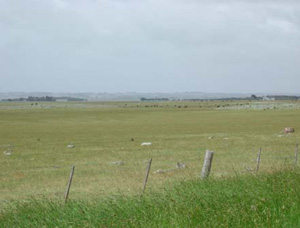CLRA49
|
| CLRA49 |  Eutrophic, Mesonatric, Black Sodosol | |
| The Sanctuary (Ramsay Road), Mount Gellibrand district, south-west Victoria | |||
| Undulating lava rises | |||
| Quaternary Newer Volcanics: extrusive valley filling basalts | |||
| Upper slope | |||
| 1–2% | |||
| South-west | |||
Horizon | Depth (cm) | Description | ||
A | 0–10 | Very dark greyish brown (10YR3/2); fine sandy clay loam; strong fine prismatic, parting to fine subangular blocky structure; rough ped fabric; weak consistence (moderately moist); non-calcareous, pH 7.0; clear boundary to: | ||
B21 | 10–30 | Very dark greyish brown (10YR3/2) with many fine distinct yellowish red (5YR5/8) mottles; heavy clay; strong medium prismatic, parting to medium and fine angular blocky structure; smooth ped fabric; very firm consistence (moderately moist); non-calcareous, pH 7.0; gradual boundary to: | ||
B22 | 30–100 | Dark grey (2.5Y4/1); heavy clay; strong medium prismatic, parting to fine and very fine prismatic structure; smooth ped fabric; firm consistence (moist); very few fine manganiferous concretions; non-calcareous, pH 9.0; clear boundary to: | ||
B2k | 100–140+ | Olive (5Y5/3); light medium clay; strong medium prismatic, parting to fine and very fine prismatic structure; smooth ped fabric; firm consistence (moist); common coarse calcareous segregations (soft); very highly calcareous, pH 9.0. | ||
| Management considerations | ||||
| This soil has a strong texture contrast between the shallow surface soil and the heavy subsoil. This can have a major effect by reducing and/or redirecting the internal drainage and restricting root growth beyond the upper horizons, influenced by the soil structure. The subsoil is mottled, alkaline and sodic. Sodic subsoils usually have poor structure (generally as coarse domed columns), however, the surface and upper subsoil have moderate to fine structure, the surface may be self-mulching. The poor structure resulting from dispersion (and subsequent clogging of pores), restricting water and gas movement through the subsoil as evidenced by mottling. These soils are hardsetting and have limited opportunity for cultivation without further damage to soil structure. These soils also have a high shrink-swell capacity, which may affect root development. The application of gypsum is used to counter the effect of the sodicity. Penetration by deep-rooted crops is also useful as is minimum tillage practices which avoids bring the sodic, dispersive material to the surface. Salinity of the subsoil is also an issue, increasing stress on root systems. | ||||
Analytical data
Site CLRA49 | Sample depth | pH | EC | NaCl | Ex Ca | Ex Mg | Ex K | Ex Na | Ex Al | Ex Acidity | FC –10kPa | PWP –1500kPa | KS | FS | Z | C | |
Horizon | cm | H2O | CaCl2 | dS/m | % | cmolc/kg | cmolc/kg | cmolc/kg | cmolc/kg | mg/kg | cmolc/kg | % | % | % | % | % | % |
A | 0–10 | 6.3 | 5.2 | 0.18 | N/R | 3.4 | 6.8 | 0.53 | 2.3 | N/R | N/R | N/R | N/R | N/R | N/R | N/R | N/R |
B21 | 10–30 | 8.3 | 7.4 | 0.57 | N/R | 7.1 | 18 | 1 | 7.8 | N/R | N/R | N/R | N/R | N/R | N/R | N/R | N/R |
B22 | 30–100 | 9.2 | 8.7 | 1.2 | N/R | 7.3 | 21 | 0.8 | 10 | N/R | N/R | N/R | N/R | N/R | N/R | N/R | N/R |
B2k | 100–140+ | 9.3 | 8.8 | 1.3 | N/R | 7.6 | 20 | 0.8 | 9.8 | N/R | N/R | N/R | N/R | N/R | N/R | N/R | N/R |



